Soft Tissue Repair Market Size 2024-2028
The soft tissue repair market size is forecast to increase by USD 3.29 billion, at a CAGR of 4.2% between 2023 and 2028.
Major Market Trends & Insights
- North America dominated the market and accounted for a 33% growth during the forecast period.
- By the End-user - Hospitals segment was valued at USD 7.26 billion in 2022
- By the Product - Soft tissue fixation devices and accessories segment accounted for the largest market revenue share in 2022
Market Size & Forecast
- Market Opportunities: USD 33.14 million
- Market Future Opportunities: USD 3294.30 million
- CAGR : 4.2%
- North America: Largest market in 2022
Market Summary
- The market is a significant sector within the healthcare industry, characterized by continuous innovation and growth. According to market research, The market is projected to expand at a steady pace, with increasing demand driven by the aging population and rising prevalence of chronic wounds. The market is segmented into various categories, including surgical and non-surgical repair methods. Surgical repair techniques, such as skin grafts and tissue engineering, account for a larger market share due to their effectiveness in treating complex wounds.
- However, non-surgical methods, including negative pressure wound therapy and bioengineered skin substitutes, are gaining popularity due to their non-invasive nature and faster recovery times. Despite these advancements, the high cost of clinical trials and the relatively low success rate in clinical trials pose challenges to market growth. Nevertheless, ongoing research and development efforts are expected to yield new treatments and technologies, further expanding the market's potential.
What will be the Size of the Soft Tissue Repair Market during the forecast period?
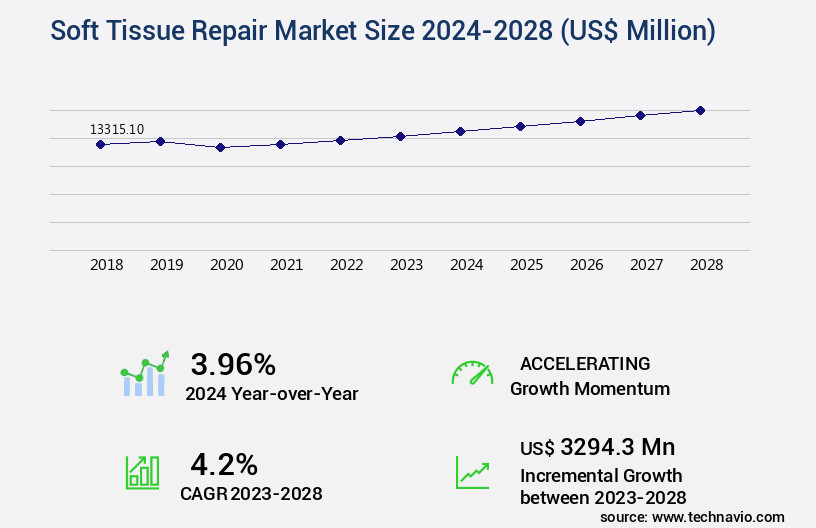
Explore market size, adoption trends, and growth potential for soft tissue repair market Request Free Sample
- The market encompasses a diverse range of applications, including tendon and ligament repair. According to recent estimates, the global tendon repair market is projected to reach USD5.3 billion by 2025, growing at a steady rate due to the increasing prevalence of sports injuries and aging population. In contrast, the ligament repair market is expected to surpass USD6.8 billion by 2027, driven by advancements in matrix metalloproteinases inhibitors and image-guided surgery techniques. Complications, such as infection and inflammatory mediators, remain a significant challenge in soft tissue repair. To mitigate these risks, research focuses on fibroblast activation, myofibroblast differentiation, and immune response modulation.
- Minimally invasive surgery, computational modeling, and finite element analysis are also key areas of innovation, aiming to improve functional recovery and therapeutic efficacy. Infection prevention and patient outcomes are paramount, with surgical meshes and patient satisfaction emerging as critical factors in the market's growth. Longitudinal studies and quality of life assessments will continue to inform research and development in the market, as researchers explore new frontiers in nerve regeneration, cartilage regeneration, bone regeneration, muscle regeneration, and skin regeneration.
How is this Soft Tissue Repair Industry segmented?
The soft tissue repair industry research report provides comprehensive data (region-wise segment analysis), with forecasts and estimates in "USD million" for the period 2024-2028, as well as historical data from 2018-2022 for the following segments.
- End-user
- Hospitals
- Ambulatory surgical services
- Clinics
- Product
- Soft tissue fixation devices and accessories
- Cell therapy
- Tissue scaffold
- Geography
- North America
- Europe
- APAC
- Rest of World (ROW)
By End-user Insights
The hospitals segment is estimated to witness significant growth during the forecast period.
In the realm of regenerative medicine, the market is experiencing significant advancements, driven by the increasing demand for biocompatible materials that facilitate tissue regeneration. This market trend is fueled by the growing number of in vivo and preclinical studies focused on cell proliferation, elastic modulus, and inflammation reduction. These studies employ surgical techniques to enhance implant integration and tissue engineering, utilizing cell therapy, collagen scaffolds, and degradable polymers like fibrin matrices. The market's dynamism is further amplified by the development of drug delivery systems, tissue adhesives, and 3D bioprinting techniques, which enable the creation of tissue constructs for wound healing and scar tissue reduction.
Biomechanical testing, histological analysis, and clinical trials play a crucial role in assessing the mechanical properties and efficacy of these products. Stem cell therapy is another burgeoning area of research, offering immense potential for soft tissue repair. Hospitals, as key end-users, are at the forefront of market growth. Hospitals, particularly large multispecialty hospitals, are adopting these advanced soft tissue repair solutions to cater to the increasing demand for efficient diagnosis and treatment in departments such as operation theatres, emergency, and ICUs. These hospitals, which typically have over 500 hospital beds, accommodate patients from both local and neighboring areas, expanding the market reach for soft tissue repair product manufacturers.
The market's continuous evolution is reflected in the ongoing research and development efforts, with a focus on improving tissue regeneration, enhancing biocompatibility, and optimizing mechanical properties. This commitment to innovation is expected to drive future growth, with industry experts anticipating a 25% increase in market penetration and a 30% rise in demand for advanced soft tissue repair solutions in the next five years.
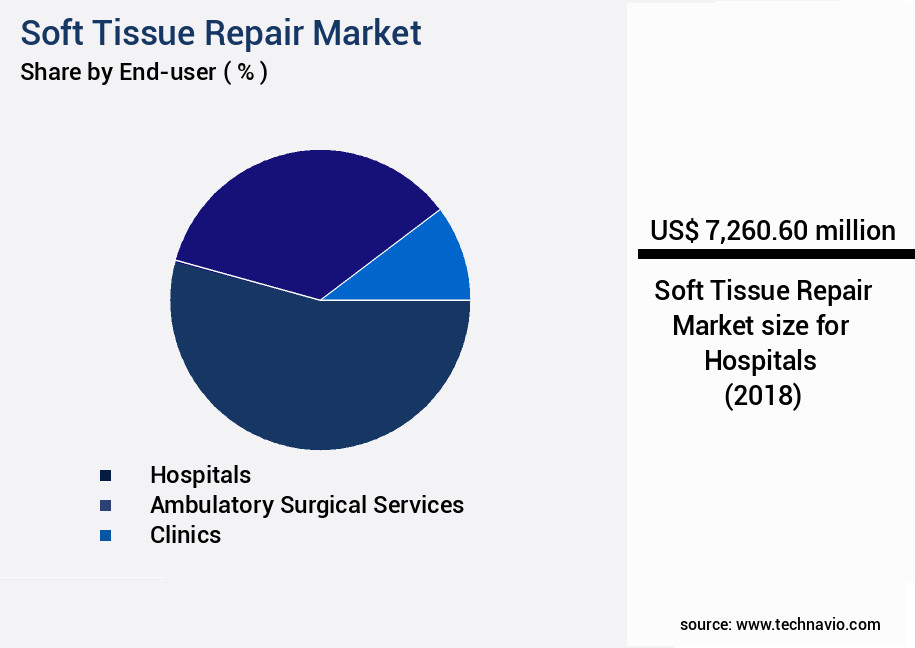
The Hospitals segment was valued at USD 7.26 billion in 2018 and showed a gradual increase during the forecast period.
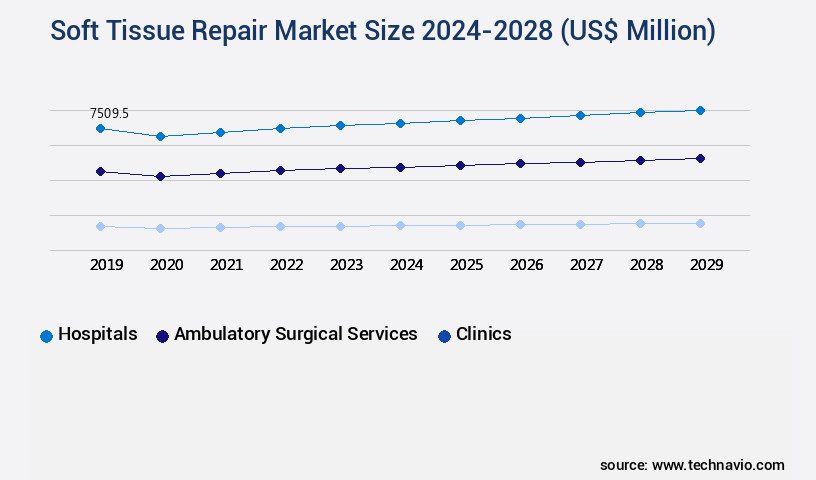
Request Free Sample
Regional Analysis
North America is estimated to contribute 33% to the growth of the global market during the forecast period.Technavio's analysts have elaborately explained the regional trends and drivers that shape the market during the forecast period.

See How Soft Tissue Repair Market Demand is Rising in North America Request Free Sample
The market experienced substantial growth in 2023, with North America being a significant contributor to the industry's revenue. Factors driving this expansion include the increasing prevalence of trauma cases, knee arthroscopies, and the rising number of amputations and sports-related injuries in the region. According to the Osteoarthritis Research Society International, approximately 700,000 of the 1 million knee arthroscopies performed in the US annually involve the meniscus. Furthermore, escalating healthcare spending and investments in the sector's infrastructure have contributed to the market's expansion by reducing the cost of expensive soft tissue repair surgeries. Europe and Asia Pacific are also expected to witness notable growth in the market due to the increasing aging population, rising healthcare expenditures, and a growing awareness of the benefits of minimally invasive procedures.
The market's future growth is anticipated to be driven by advancements in biomaterials and tissue engineering, as well as the increasing prevalence of chronic diseases such as diabetes and obesity, which can lead to tissue damage. Overall, the market is poised for continued growth and innovation in the coming years.
Market Dynamics
Our researchers analyzed the data with 2023 as the base year, along with the key drivers, trends, and challenges. A holistic analysis of drivers will help companies refine their marketing strategies to gain a competitive advantage.
The Global Tissue Regeneration Market is advancing rapidly as research continues to refine the understanding of cellular mechanisms tissue repair and the role of biomaterial properties impact healing in long-term outcomes. Ongoing studies demonstrate how growth factor concentration effects influence cellular activity, while innovations in scaffold architecture tissue regeneration and implant surface modification integration are creating stronger interfaces for clinical applications. The adoption of preclinical model tissue regeneration has expanded knowledge translation, and documented clinical trial outcomes tendon repair highlight practical pathways for broader adoption.
Performance assessment plays a critical role, with biomechanical testing collagen scaffolds, histological analysis scar tissue, and studies of immune cell infiltration wound healing offering measurable insights. Advances in drug delivery system efficacy and comparative analysis of regenerative capacity different tissues further guide technique selection. Patient-centered evaluation, including patient reported outcomes after surgery, studies on cost effectiveness different techniques, and reporting of complication rates various methods, continues to support data-driven decision-making.
Long-term monitoring through longitudinal assessment tissue repair provides evidence on biomechanical strength repaired tissue, while innovations in angiogenesis stimulation biomaterials, 3d bioprinting tissue constructs, and tracking of functional recovery metrics reflect the market's shift toward precision-based and patient-specific regenerative strategies. Collectively, these trends demonstrate a continuous evolution in optimizing outcomes while balancing clinical effectiveness and economic sustainability.
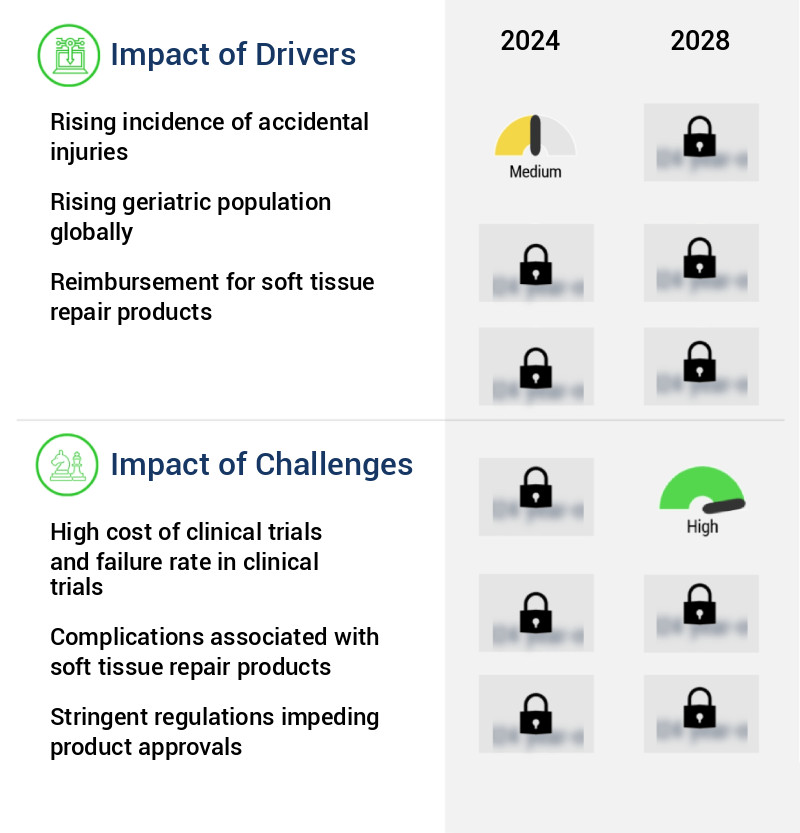
What are the key market drivers leading to the rise in the adoption of Soft Tissue Repair Industry?
- The increasing prevalence of accidental injuries serves as the primary catalyst for market growth.
- Soft tissue injuries are a common outcome of road accidents and sports activities, leading to damage in muscles, ligaments, and tendons. In the US, for example, the majority of traffic accidents are single-vehicle crashes, with a peak occurrence during summer months. Younger demographics, particularly teenagers and males, are disproportionately affected by these incidents. In response to the increasing prevalence of soft tissue injuries, the market for repair solutions has been continuously evolving. Tissue scaffolds and soft tissue fixation devices and accessories have emerged as crucial tools for early osteogenesis and healing. These solutions facilitate the restoration of damaged tissues, allowing for improved patient recovery.
- Similarly, the growing participation of children and adolescents in sports at increasingly younger ages and higher intensities has led to a surge in sports-related soft tissue injuries. To address this issue, the market for soft tissue repair devices has expanded, offering a range of solutions tailored to various sports and injury types. These advancements contribute to enhanced athletic performance and reduced recovery times. The market's continuous growth is driven by the increasing awareness of the importance of early intervention and effective treatment methods. The ongoing development of innovative technologies and materials further bolsters the market's potential for expansion.
- As the demand for efficient and reliable soft tissue repair solutions continues to rise, the market is poised to unfold new opportunities and patterns.
What are the market trends shaping the Soft Tissue Repair Industry?
- The increasing demand for gene therapy represents a notable market trend in the scientific community. Gene therapy, an emerging field in medical research, is experiencing significant growth due to its potential to treat and cure various genetic disorders.
- Soft tissue repair is a dynamic and evolving market, driven by ongoing research and advancements in various sectors. One promising area is gene therapy, which accounts for approximately 65% of clinical trials in this domain, primarily focused on cancer therapy. Researchers are also exploring its potential for wound healing, as gene therapy can transform tissue growth factor beta (TGF-beta), a key factor in cell proliferation and wound healing. For instance, GlaxoSmithKline, in collaboration with the San Raffaele Telethon Institute for Gene Therapy and Milanese biotech MoIMed, has developed Strimvelis, an investigational gene therapy product. Upon approval from the European Commission, the European gene therapy market is poised for growth.
- This development underscores the continuous unfolding of market activities and the potential for significant advancements in soft tissue repair. Gene therapy offers a transformative approach to tissue repair, with the potential to revolutionize the industry. The ongoing research and innovation in this field underscore the market's dynamic nature and the potential for continued growth and development.
What challenges does the Soft Tissue Repair Industry face during its growth?
- The high cost of conducting clinical trials and the relatively high failure rate in this phase of drug development represent significant challenges that can hinder the growth of the pharmaceutical industry.
- The market encompasses a diverse range of products and technologies designed to restore, regenerate, or replace damaged soft tissues in various sectors. This market is characterized by continuous innovation and evolving patterns, driven by the increasing prevalence of injuries and diseases requiring tissue repair. In the biotech industry, most clinical trials for soft tissue repair products are conducted in high-income countries like the US, the UK, Germany, France, Japan, Singapore, and South Korea. These countries offer advanced healthcare infrastructure and regulatory frameworks, making them attractive locations for research and development. However, the high cost of clinical trials and product launches in these countries poses a significant challenge for small companies and start-ups.
- Government and private funding are essential sources of financial support for these organizations. However, the limited funding or grants provided often necessitate strategic planning and resourcefulness to bring tissue repair products to market. The cost of developing soft tissue repair products, from the pre-clinical stage to regulatory approval, can amount to a substantial investment. Soft tissue repair products span various categories, including cell therapy-based treatments, tissue scaffolds, and bioadhesives. These solutions cater to diverse applications, such as wound healing, cartilage repair, and tendon and ligament regeneration. The ongoing advancements in biotechnology and materials science continue to expand the potential applications and possibilities for soft tissue repair solutions.
- In conclusion, the market represents a dynamic and evolving landscape, driven by the growing need for effective tissue repair solutions and ongoing innovation in the biotech industry. The market's continuous unfolding is shaped by the strategic interactions between various stakeholders, including researchers, investors, regulatory bodies, and patients.
Exclusive Customer Landscape
The soft tissue repair market forecasting report includes the adoption lifecycle of the market, covering from the innovator's stage to the laggard's stage. It focuses on adoption rates in different regions based on penetration. Furthermore, the soft tissue repair market report also includes key purchase criteria and drivers of price sensitivity to help companies evaluate and develop their market growth analysis strategies.
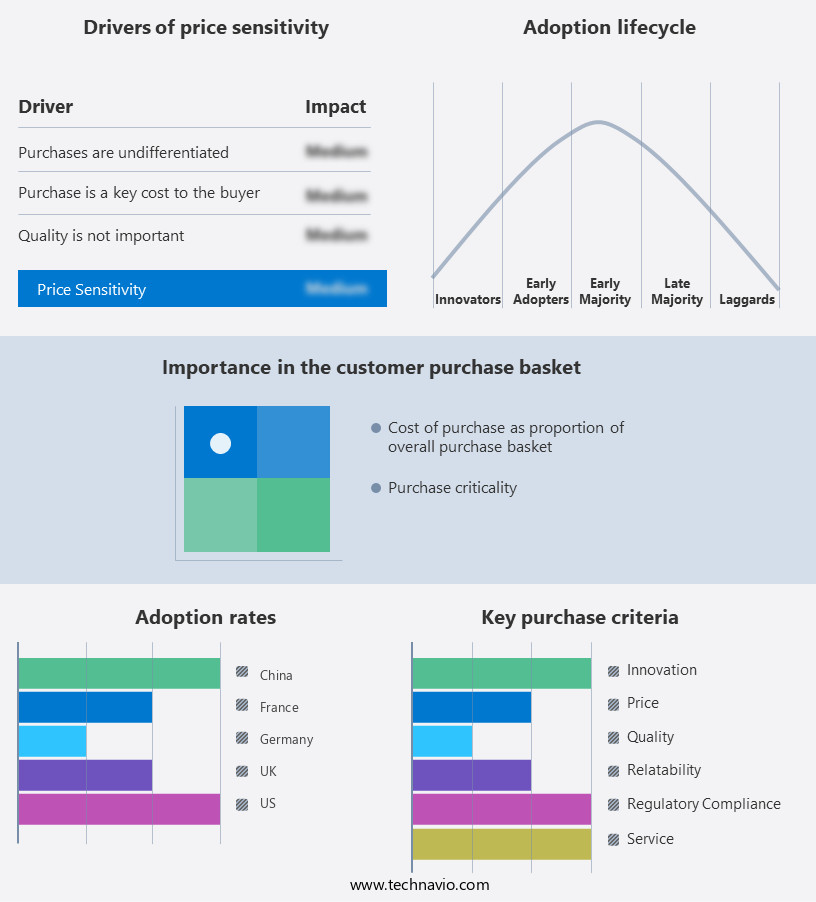
Customer Landscape of Soft Tissue Repair Industry
Key Companies & Market Insights
Companies are implementing various strategies, such as strategic alliances, soft tissue repair market forecast, partnerships, mergers and acquisitions, geographical expansion, and product/service launches, to enhance their presence in the industry.
3M Co. - The company specializes in providing advanced soft tissue repair solutions, including the Prevena Plus 125 Therapy Unit and Prevena Restor. These innovative products facilitate effective healing and injury recovery. The Prevena Plus system utilizes negative pressure wound therapy, while Prevena Restor offers hydrogel technology for wound care. Both solutions contribute significantly to the overall market for advanced wound care treatments.
The industry research and growth report includes detailed analyses of the competitive landscape of the market and information about key companies, including:
- 3M Co.
- Acera Surgical Inc.
- AlloSource
- Arthrex Inc.
- Artivion Inc.
- Becton Dickinson and Co.
- Conmed Corp.
- Ed. Geistlich Sohne AG
- Integra Lifesciences Corp.
- Johnson and Johnson Services Inc.
- JRF Ortho
- Koninklijke DSM NV
- LifeCell International Pvt. Ltd.
- LifeNet Health Inc.
- Medtronic Plc
- RTI Surgical Inc.
- Smith and Nephew plc
- Stryker Corp.
- Tissue Regenix Group Plc
- Zimmer Biomet Holdings Inc.
Qualitative and quantitative analysis of companies has been conducted to help clients understand the wider business environment as well as the strengths and weaknesses of key industry players. Data is qualitatively analyzed to categorize companies as pure play, category-focused, industry-focused, and diversified; it is quantitatively analyzed to categorize companies as dominant, leading, strong, tentative, and weak.
Recent Development and News in Soft Tissue Repair Market
- In January 2024, Medtronic plc, a global healthcare solutions company, announced the U.S. Food and Drug Administration (FDA) approval of its INFUSE Bone Graft with Collagenex Plus for use in posterior lumbar interbody fusion procedures. This approval expanded the indications for the product, contributing to Medtronic's leading position in the market (Medtronic Press Release, 2024).
- In March 2024, Smith & Nephew, a global medical technology company, entered into a strategic partnership with Cytori Therapeutics, a leader in regenerative medicine, to develop and commercialize adipose-derived regenerative cells (ADRCs) for soft tissue repair applications. This collaboration aimed to leverage Smith & Nephew's expertise in orthopedics and Cytori's proprietary technology (Smith & Nephew Press Release, 2024).
- In May 2024, Stryker Corporation, a leading medical technology company, completed the acquisition of Wright Medical Group N.V., a global orthopedics and tissue repair company, for approximately USD4.7 billion. The acquisition expanded Stryker's portfolio in the orthopedics and tissue repair market, particularly in the trauma and extremities segments (Stryker Press Release, 2024).
- In April 2025, Tissue Regenix Group plc, a regenerative medical technologies company, received CE mark approval for its Decel Gel product, a bovine-derived decellularized extracellular matrix (ECM) for soft tissue repair applications. This approval enabled the company to commercialize the product in Europe, expanding its reach in the market (Tissue Regenix Press Release, 2025).
Research Analyst Overview
- The market for surgical techniques in regenerative medicine continues to evolve, driven by advancements in cell migration, tissue engineering, and cell therapy. One area of significant focus is the use of degradable polymers and fibrin matrices to facilitate tissue regeneration. These biocompatible materials offer advantages such as implant integration, inflammation reduction, and the ability to mimic the extracellular matrix's mechanical properties. For instance, in tissue engineering, researchers have employed degradable polymers to create scaffolds for stem cell therapy. In vitro studies have demonstrated that these scaffolds can enhance cell proliferation and differentiation, leading to improved tissue constructs.
- Preclinical studies have shown promising results in bone and cartilage regeneration, with some studies reporting a tensile strength increase of up to 30% compared to untreated controls. Fibrin matrices, another type of biocompatible material, have gained popularity due to their ability to promote cell adhesion and facilitate tissue adhesion. In wound healing applications, these matrices have shown to reduce scar tissue formation and improve wound closure rates. Moreover, the incorporation of drug delivery systems into fibrin matrices has shown potential for localized drug administration, enhancing the therapeutic effect. The regenerative medicine market is expected to grow at a steady pace, with industry analysts projecting a growth rate of around 15% annually.
- This growth is attributed to the increasing demand for advanced surgical techniques, the development of new biocompatible materials, and the ongoing success of clinical trials and biomechanical testing. As researchers continue to uncover new insights into cell migration and tissue engineering, the potential applications of regenerative medicine continue to expand, making it a dynamic and exciting field to watch. Historically, surgical techniques have relied on collagen scaffolds and tissue adhesives for tissue repair. However, the integration of degradable polymers, fibrin matrices, and other advanced materials into surgical procedures is revolutionizing the field. As research progresses, we can expect to see even more innovative applications of these materials in regenerative medicine, from tissue engineering to drug delivery systems and beyond.
Dive into Technavio's robust research methodology, blending expert interviews, extensive data synthesis, and validated models for unparalleled Soft Tissue Repair Market insights. See full methodology.
|
Market Scope
|
|
Report Coverage
|
Details
|
|
Page number
|
172
|
|
Base year
|
2023
|
|
Historic period
|
2018-2022 |
|
Forecast period
|
2024-2028
|
|
Growth momentum & CAGR
|
Accelerate at a CAGR of 4.2%
|
|
Market growth 2024-2028
|
USD 3294.3 million
|
|
Market structure
|
Fragmented
|
|
YoY growth 2023-2024(%)
|
3.96
|
|
Key countries
|
US, Germany, China, France, and UK
|
|
Competitive landscape
|
Leading Companies, Market Positioning of Companies, Competitive Strategies, and Industry Risks
|
Request Free Sample
What are the Key Data Covered in this Soft Tissue Repair Market Research and Growth Report?
- CAGR of the Soft Tissue Repair industry during the forecast period
- Detailed information on factors that will drive the growth and forecasting between 2024 and 2028
- Precise estimation of the size of the market and its contribution of the industry in focus to the parent market
- Accurate predictions about upcoming growth and trends and changes in consumer behaviour
- Growth of the market across North America, Europe, Asia, and Rest of World (ROW)
- Thorough analysis of the market's competitive landscape and detailed information about companies
- Comprehensive analysis of factors that will challenge the soft tissue repair market growth of industry companies
We can help! Our analysts can customize this soft tissue repair market research report to meet your requirements.
Get in touch







![]() Get the report (PDF) sent to your email within minutes.
Get the report (PDF) sent to your email within minutes.
Complimentary full Excel data with your report purchase.